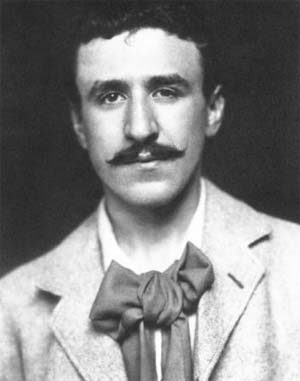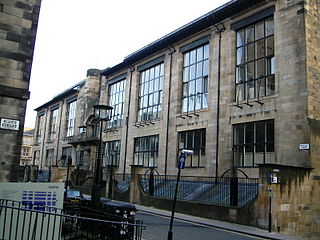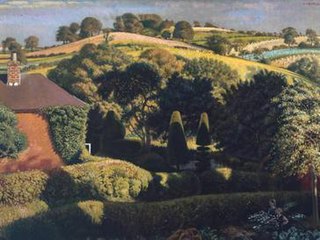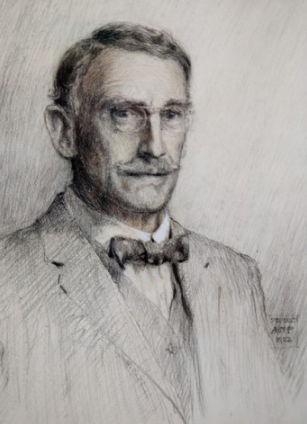Related Research Articles

Charles Rennie Mackintosh was a Scottish architect,designer,water colourist and artist. His artistic approach had much in common with European Symbolism. His work,alongside that of his wife Margaret Macdonald,was influential on European design movements such as Art Nouveau and Secessionism and praised by great modernists such as Josef Hoffmann. Mackintosh was born in Glasgow and died in London. He is among the most important figures of Modern Style.

Margaret Macdonald Mackintosh was an English-born artist who worked in Scotland,and whose design work became one of the defining features of the Glasgow Style during the 1890s - 1900s.

Helensburgh is an affluent coastal town on the north side of the Firth of Clyde in Scotland,situated at the mouth of the Gareloch. Historically in Dunbartonshire,it became part of Argyll and Bute following local government reorganisation in 1996.

The Glasgow School of Art is a higher education art school based in Glasgow,Scotland,offering undergraduate degrees,post-graduate awards,and PhDs in architecture,fine art,and design.

The Hunterian is a complex of museums located in and operated by the University of Glasgow in Glasgow,Scotland. It is the oldest museum in Scotland. It covers the Hunterian Museum,the Hunterian Art Gallery,the Mackintosh House,the Zoology Museum and the Anatomy Museum,which are all located in various buildings on the main campus of the university in the west end of Glasgow.

Douglas Percy Bliss was a Scottish painter and art conservationist. Bliss's family was of Northamptonshire,England. His grandfather moved to Moray,Scotland. Bliss himself was born in Karachi,India. Bliss was raised in Edinburgh and educated at George Watson's College from 1906–17. He always regarded himself as Scottish.

The Hill House in Helensburgh,Scotland,was created by architects and designers Charles and Margaret Macdonald Mackintosh. The house is an example of the Modern Style. It was designed and built for the publisher Walter Blackie in 1902–1904.

Catherine Cranston,widely known as Kate Cranston or Miss Cranston,was a leading figure in the development of tea rooms. She is nowadays chiefly remembered as a major patron of Charles Rennie Mackintosh and Margaret MacDonald,in Glasgow,Scotland. The name of Miss Cranston's Tea Rooms lives on in reminiscences of Glasgow in its heyday.

The Modern Style is a style of architecture,art,and design that first emerged in the United Kingdom in the mid-1880s. It was the first Art Nouveau style worldwide,and it represents the evolution of the Arts and Crafts movement which was native to Great Britain. The Modern Style provided the base and intellectual background for the Art Nouveau movement and was adapted by other countries,giving birth to local variants such as Jugendstil and the Vienna Secession. It was cultivated and disseminated through the Liberty department store and The Studio magazine.

The city of Glasgow,Scotland is particularly noted for its 19th-century Victorian architecture,and the early-20th-century "Glasgow Style",as developed by Charles Rennie Mackintosh.

Talwin Morris was a prolific book designer and decorative artist working in the late 19th and early 20th centuries,particularly known for his Glasgow Style furniture,metalwork and book designs.

The Glasgow Society of Lady Artists was founded in 1882 by eight female students of the Glasgow School of Art with the aim of affording due recognition to women in the field of art. It has been described by Jude Burkhauser as "the first residential club in Scotland run by and for women". In the early days of the club,they met at 136 Wellington Street,Glasgow.

William Leiper FRIBA RSA (1839–1916) was a Scottish architect known particularly for his domestic architecture in and around the town of Helensburgh. In addition,he produced a small amount of fine ecclesiastical and commercial architecture in Glasgow and the Scottish Lowlands. He was also an accomplished watercolour artist,and from the late 1870s spent much spare time painting in oils and watercolours.

The Fairfield Heritage Centre is situated on Govan Road,Glasgow,Scotland. Built as the offices of Fairfield Shipbuilding and Engineering Co Ltd between 1889 and 1891 the building was used as the principal offices for successive owners of the adjacent shipyard until 2001,when it was vacated by BAE Systems Marine. After deteriorating unused for eight years it was bought by social enterprise charity Govan Workspace in 2009. Following a restoration costing over £5.8m it was re-occupied as a heritage centre and commercial offices in 2013.
Events from the year 1903 in Scotland.
Randolph Schwabe was a British draughtsman,painter and etcher who was the Slade Professor of Fine Art at University College London from 1930 until his death. He served as a war artist in both World Wars,created designs for theatrical productions and illustrated a number of books.

John Keppie was a Glasgow architect and artist. From an early age he was a close friend of Edward Atkinson Hornel and would often bring in New Year with him in Kirkcudbright. Within the architectural profession,he was closest to John Archibald Campbell,and is credited with training Charles Rennie Mackintosh.

Gareth Dale Hoskins OBE was a Scottish architect.
Jane Younger (1863–1955) was a Scottish artist known for her watercolour paintings and embroidery work.

Alexander Nisbet Paterson ARIBA PRIAS (1862–1947) was a Scottish architect,mainly working in the Arts and Crafts style. He was president of the Royal Institute of Architects in Scotland (RIAS).
References
- 1 2 3 4 5 6 "Barnes, Sir Harry Jefferson - Glasgow School of Art: Archives & Collections". gsaarchives.net.
- 1 2 3 4 Glasgow School of Art, The History. Hugh Ferguson. Foulis Press. 1995.
- 1 2 3 "Helensburgh Heritage Trust". www.helensburgh-heritage.co.uk.
- ↑ "Postgraduate Funding | Sir Harry Barnes Scholarship from Glasgow School of Art".